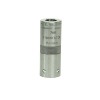I've been loading pistol and rifle for about 10 years now, never came across this issue. This is my first belted case, for what it's worth.
I got new Hornady 300 WM brass, full-length sized it in a standard RCBS die. Checked trim length, chamfered, deburred. Tumbled clean. Primed. Drops into my Lyman case gage like butter. Dropped powder, seated a 200-gr Sierra GameKing, and about a third of them hang up in the case gage right around the web. So they're almost in there, but not.
I'm not sure if they're hanging up on the web, the shoulder, the mouth, or what. Caliper measurements of those places seem identical to the cases that still gauge like butter after bullet seating.
Further details:
RCBS standard seating die
COAL standard 3.34
Lee Classic Cast Press
Elevation 8900 feet
Zodiac sign Aries
I'm loading these for a buddy's hunting rifles, so nothing creative going on. I'm not crimping these rounds since (as far as I know) there's no reason to. I'd experiment with that, but I don't even have a crimp die in this caliber. I just set the bullet seater to create the SAAMI OAL and called it a day.
Ladies and gents, what is going on?
I got new Hornady 300 WM brass, full-length sized it in a standard RCBS die. Checked trim length, chamfered, deburred. Tumbled clean. Primed. Drops into my Lyman case gage like butter. Dropped powder, seated a 200-gr Sierra GameKing, and about a third of them hang up in the case gage right around the web. So they're almost in there, but not.
I'm not sure if they're hanging up on the web, the shoulder, the mouth, or what. Caliper measurements of those places seem identical to the cases that still gauge like butter after bullet seating.
Further details:
RCBS standard seating die
COAL standard 3.34
Lee Classic Cast Press
Elevation 8900 feet
Zodiac sign Aries
I'm loading these for a buddy's hunting rifles, so nothing creative going on. I'm not crimping these rounds since (as far as I know) there's no reason to. I'd experiment with that, but I don't even have a crimp die in this caliber. I just set the bullet seater to create the SAAMI OAL and called it a day.
Ladies and gents, what is going on?


